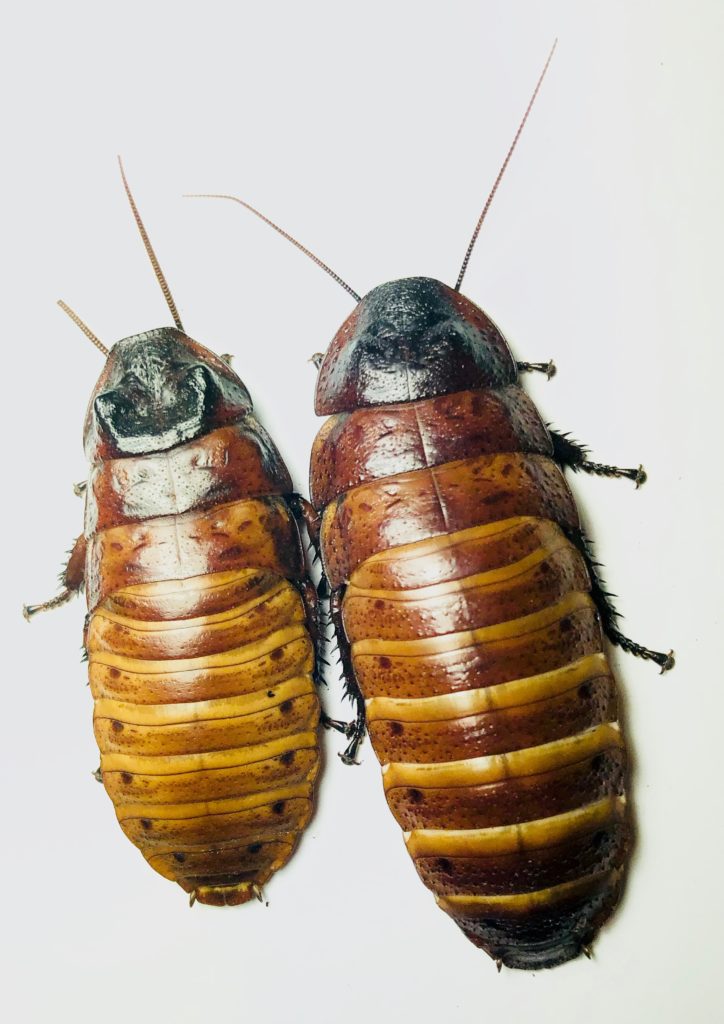Description
Common Hisser (Gromphadorhina portentous) LLE Mahogany is like the name suggests mahogany in color over much of its body with the pronotum slightly richer brown. They obtain very good size if husbandry is good. You can expect to produce adults upward to 3inches in length.
Origin
This species like all hissers originate from the islands of Madagascar. LLE Mahogany was selected by Limberlost Exotics in 2016 from a verified and known pure strain of common hissers. I noticed some very interesting females in 2016 that were all brown and had no black in them whatsoever. I isolated these females and over the last two years have been weeding out any adults that exhibit black markings. They now produce nearly 90% consistent look and will get even more stable as time goes by. Kyle from Roach Crossing is the only other person currently that has a breeding colony of these gorgeous roaches. I trusted Kyle with this rather new and stable look because he knows how to keep the strain pure and continue to select for these traits to strengthen them.
Reproduction
Females release pheromones when receptive and mate with select males. Males establish the right to mate by pushing each around using bumpy protrusions on the top of the pronotum. Females produce a long yellow egg case (ootheca) that they retain inside their abdomen for about 60 days. Egg cases contain 30-100 plus eggs. The eggs hatch inside the female and the nymphs are then expelled out. Newly emerged nymphs are pure white until there exoskeleton hardens and darkens. Nymphs crowd around a thick secretion that provides initial sustenance. Sometimes if conditions are not optimal, crowded, or nutrition lacking females may “abort” or expel the partially developed ootheca. Reproduction is inhibited if temperatures are not maintained above 80 degrees.
Development
Nymphs go through a period of 6-7 molts over a period of 6-10 months. Development is largely influenced on temperature as well as nutritional quality. Nymphs often eat some or all of their old shed. If the humidity is not maintained molting problems can occur.
Nutrition
Hissing roaches will eat a wide range of produce, however it should be organic and you should avoid foods that naturally contain phytates and oxalates. I find that feeding hissing roaches organic bananas, oranges, and zucchini works well. I prefer to soak a high protein dog puppy food as the roaches can consume it much easier.
Housing
If you have a small colony they should be housed in a small container. They seem to breed best when kept slightly crowded. This also keeps them in close proximity with their food and water. The media that you place them on should be a mixture of peat and well-rotted compost. The mix should be just barely moist and not soggy. Many people use egg cartons, however I have found that using natural pieces of tree bark stacked toward the back to provide lots of shelter promotes breeding and proper humidity naturally. I like to keep the back half of the tank on the heat mat. I will mist the tank or dump water into the back half were it will naturally evaporate and provide humidity.
Rearing notes
LLE Mahogany is very productive with females easily averaging litters of 60-70 per drop. They mature quickly if given a good high protein feed regularly as well as lots of fresh well ripened fruit.

